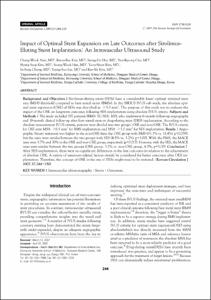KUMEL Repository
1. Journal Papers (연구논문)
1. School of Medicine (의과대학)
Dept. of Internal Medicine (내과학)
Impact of Optimal Stent Expansion on Late Outcomes After Sirolimus-Eluting Stent Implantation: An Intravascular Ultrasound Study
- Keimyung Author(s)
- Nam, Chang Wook; Kim, Kwon Bae; Hur, Seung Ho; Cho, Yun Kyeong; Kim, Hyung Seop; Han, Seong Wook; Kim, Yoon Nyun; Chung, In Sung
- Journal Title
- Korean Circulation Journal
- Issued Date
- 2007
- Volume
- 37
- Issue
- 6
- Keyword
- Intravascular ultrasonography; Stents; Outcomes
- Abstract
- Background and Objectives : Sirolimus-eluting stents (SESs) have a considerably lower optimal minimal stent area (MSA) threshold compared to bare metal stents (BMSs). In the SIRIUS IVUS sub study, the absolute optimal stent expansion (OSE) of SESs was described as ≥5.0 mm2. The purpose of this study was to evaluate the impact of the OSE on long-term outcomes following SES implantation using absolute IVUS criteria.
Subjects and Methods : The study included 157 patients (BMS: 57; SES; 100), who underwent 6-month follow-up angiography and 18-month clinical follow-up after bare metal stent or drug-eluting stent (DES) implantation. According to the absolute measurement IVUS criteria, patients were divided into two groups: OSE and non-OSE. The IVUS criteria for OSE were MSA ≥6.5 mm2 for BMS implantation and MSA ≥5.0 mm2 for SES implantation. Results : Angiographic binary restenosis was higher in the non-OSE than the OSE group with BMS (33.3% vs. 11.4%; p<0.039), but the rates were similar between the two groups with SES (4.5% vs. 3.2%; p=1.00). With the BMS, the MACE rates were 5.7% and 30% in the OSE and non-OSE group, respectively (p=0.017). However, with the SES, the MACE rates were similar between the two groups (OSE group, 3.2% vs. non-OSE group, 4.5%, p=1.00). Conclusion : After SES implantation, there were no significant differences in the late outcomes in relation to the achievement of absolute OSE. A variety of restenosis related factors should be considered for better outcomes after DES implantation. Therefore, the concept of OSE in the era of DESs might need to be revisited.
- Publisher
- School of Medicine
- Citation
- Chang-Wook Nam et al. (2007). Impact of Optimal Stent Expansion on Late Outcomes After Sirolimus-Eluting Stent Implantation: An Intravascular Ultrasound Study. Korean Circulation Journal, 37(6), 244–250. doi: 10.4070/kcj.2007.37.6.244
- Type
- Article
- ISSN
- 1738-5520
- 파일 목록
-
-
Download
 oak-aaa-03295.pdf
기타 데이터 / 292.86 kB / Adobe PDF
oak-aaa-03295.pdf
기타 데이터 / 292.86 kB / Adobe PDF
-
Items in Repository are protected by copyright, with all rights reserved, unless otherwise indicated.